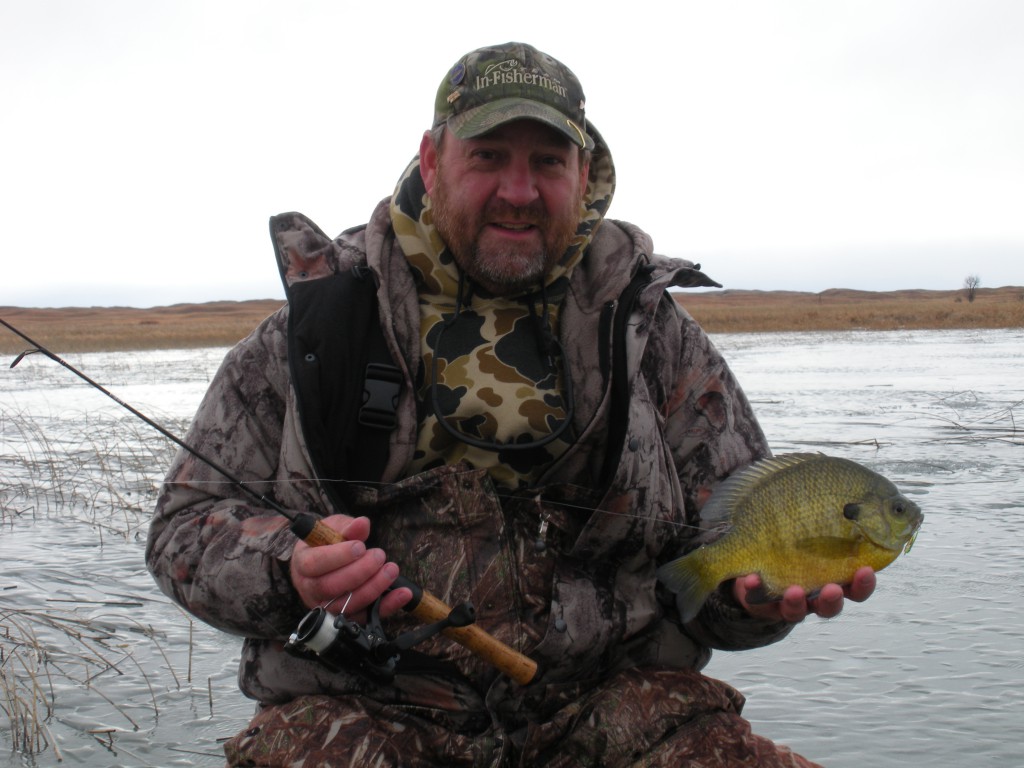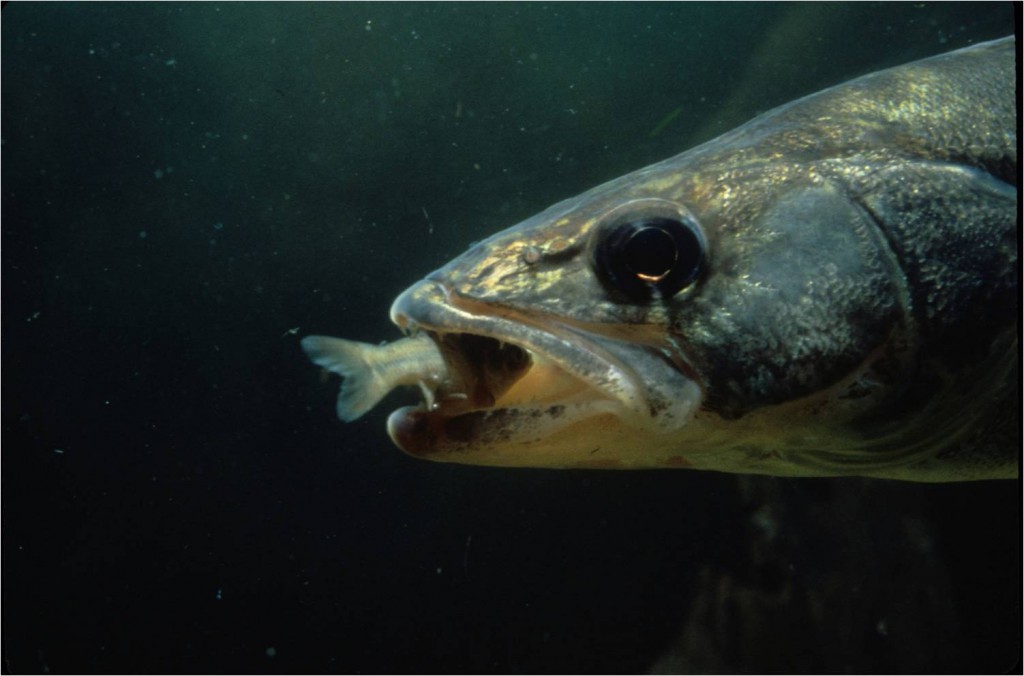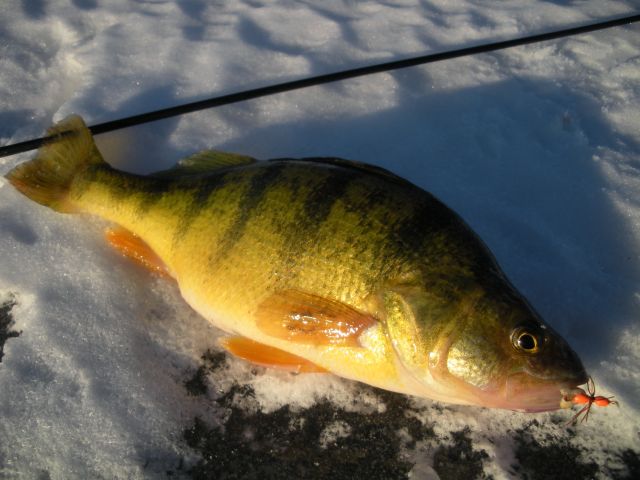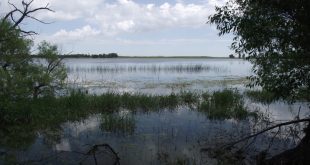Let me slip into my biologist/limnologist hat for this blog post. No, I do not actually have a biologist/limnologist hat; it is the same as my fishing cap, which by the way, is on my head most of the time.
I love to fish year-round, 12 months out of the year I will be on the water. One of my strategies when the water is cold is to slow down, fish slower. I have often told anglers that the reason slowing down usually catches more fish in cold water is because the metabolism of the fish slows as the water cools; therefore, the fish slow down. However, there are cold-water species like trout and even cool-water species like pike, muskies and walleyes that are still relatively active in cold water. In this past year my partners and I have caught plenty of trout, walleyes, sauger, muskies and pike that were very active in cold water. In fact I would tell you that most of the walleyes I have caught through Nebraska ice in recent years have been very active–mobile, agile and hostile. It is all relative, some fish remain more active at colder water temperatures, but there is some truth that all species slow as the water cools.
Recently, I was reminded of another, and even more important reason, why it is usually best to fish slower in colder water. I hate to admit that I had forgotten something from my college limnology classes (limnology is the study of lakes), and I still work with one of the guys who taught me limnology at the University of Nebraska. Please, do not tell Dr. Holland that I may have forgotten something from his class (I still have my notes from his class here on my book shelf, no kidding). Anyway, water is an amazing substance and most folks understand that it is at its densest at 39 degrees F. As water cools below 39 degrees F, it becomes less dense and that is why ice floats. But did you know that as water cools its viscosity or thickness also changes?
Now I am not talking about viscosity that changes from liquid water as we know it to “syrupy”. You and I cannot detect the change in viscosity or thickness of water, but if you think of a fish living, swimming, in the water, it would be very apparent and a huge thing to them. As water cools from the temperatures that we see in the summer, to what we see in late fall and under the ice, the viscosity of water actually is over twice as “thick”. Again, it is all relative and liquid water at any temperature is much less viscous than maple syrup, but it is much more viscous, or thick when it is cold. I will not bore you with all the physics behind the measuring of thickness or viscosity, I am not sure I understand it all, and unless you are a physicist, you probably never knew there were units of measure describing viscosity! Just remember that relatively speaking, water gets more viscous, is harder to swim through, as it cools.
And that is why it is generally better to fish slower as the water cools!
If you are an angler there are some other things you can learn from this . . . .
First of all, as the density and viscosity of water changes at different temperatures, the action or behavior of our artificial baits will change. For example, it will be easier to retrieve, “float”, a 1/4 oz. jig just above a snaggy, rocky bottom when the water is cooler and more viscous. At warmer temperatures you will HAVE to speed up to keep that same 1/4 oz. jig up off the bottom.
You may have noticed that the actually buoyancy of your neutrally-buoyant crankbaits changes at different water temperatures ( In Suspense ). Also consider that with the change in viscosity, the action of those baits also will change as the water cools. With “thicker” water those crankbaits will wobble at slower speeds. Maybe that is another reason those neutrally-buoyant crankbaits are so effective in cold water?
If you are an ice angler, you are already a step ahead of the game. Vertical presentations tend to work better for fish that are less active any time of year, and that is especially true when the water is cold. Putting a bait in front of them and keeping it there is one way to trigger bites from inactive fish. By the way, that is one reason I would much rather ice-fish than open-water fish when the water is cold–it is a lot easier to stay vertical through an ice hole!
Although metabolism rates slow, fish still feed during the winter. However, as they always do they will expend the least amount of energy possible while capturing prey. Some fish will be relatively active and aggressive under the ice, and an angler can attract those fish with relatively aggressive presentations, relatively active jigging motions. But, you will almost always have to slow down, pause, to trigger fish to bite. If the fish are not very active, less aggressive, besides slowing your presentations, “tempering” your jigging, you can slow down by fishing baits with extra surface area–plastic bodies, rubber legs, or flicker spinners for example. If you are a fly-tier, some hackle tied onto your ice fishing jigs will make them “float” more, it will slow them in the “thicker” water under the ice.
I do not expect you to ponder all of this “deep” stuff while trying to catch fish. I do not! I am trying to catch fish. But, the more we understand about the fish and the environment in which they live, the easier it is to put the pieces of the puzzle together and be successful. Do not peer into a glass of water from your favorite ice-covered lake, you will not be able to tell that water is more viscous, “thicker” than it was back in August. But, you better believe the fish swimming in that water are very aware of it, and if you want to catch them, it might help to keep that in mind!

 Nebraskaland Magazine
Nebraskaland Magazine





